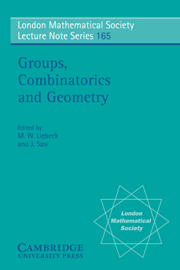Book contents
- Frontmatter
- Contents
- Authors' Addresses
- Introduction
- Part 1 Sporadic groups
- Part 2 Moonshine
- Part 3 Local and geometric methods in group theory
- Part 4 Geometries and related groups
- Part 5 Finite and algebraic groups of Lie type
- Part 6 Finite permutation groups
- Part 7 Further aspects of simple groups
- Part 8 Related topics
Introduction
Published online by Cambridge University Press: 07 September 2010
- Frontmatter
- Contents
- Authors' Addresses
- Introduction
- Part 1 Sporadic groups
- Part 2 Moonshine
- Part 3 Local and geometric methods in group theory
- Part 4 Geometries and related groups
- Part 5 Finite and algebraic groups of Lie type
- Part 6 Finite permutation groups
- Part 7 Further aspects of simple groups
- Part 8 Related topics
Summary
This book contains the proceedings of the L.M.S. Durham Symposium on Groups and Combinatorics, July 5–15, 1990, supported by the Science and Engineering Research Council of Great Britain.
The classification of finite simple groups was completed in 1980, and most of the conference was concerned with trends in group theory and related areas which have come to the fore since then. We have divided the material into eight sections, which we now outline.
Sporadic groups
During the conference, a spectacular proof of the ten-year-old Conway “Y555 conjecture” concerning a Coxeter-type presentation of the Monster sporadic group, was achieved by Norton and Ivanov. In their articles, Norton and Ivanov give details of their proof; Ivanov obtains a new geometric characterization of the Monster, and this is used by Norton to prove the conjecture. Conway's short paper outlines the background. The article of Conway and Pritchard gives a proof of the Y552 presentation for the Fischer group Fi24. In a different vein, the papers of Aschbacher and Segev concern proofs of uniqueness results for sporadic groups. In their first article they survey their general framework for providing uniqueness results; this uses a graph-theoretical setting and some ideas with a topological flavour. Their second paper discusses in detail the uniqueness proof for the group J4.
Moonshine
This section concerns the remarkable relationships between the Monster group and certain modular functions. Much insight into moonshine is gained from studying the Monster Lie algebra, which is described by Borcherds in his article.
- Type
- Chapter
- Information
- Groups, Combinatorics and Geometry , pp. xi - xivPublisher: Cambridge University PressPrint publication year: 1992

